Discover 14 remarkable animals in Ashley National Forest with our hiking guide! From majestic moose to elusive mountain lions, embark on a wildlife adventure like no other.
Get ready for a wild adventure in Ashley National Forest, a place where nature’s critters roam free and every hike is a potential wildlife safari! From majestic moose to mischievous raccoons, this sprawling forest is alive with creatures great and small.
Whether you’re a wildlife enthusiast, a photography buff, or just in it for the serene vibes, Ashley National Forest has something special in store.
Imagine locking eyes with a mountain lion (from a safe distance, of course!), watching a herd of elk graze in a meadow, or spotting the graceful glide of an osprey overhead.
In this guide, we’ll take you on a journey through the forest’s hidden spots and popular trails, all with the chance of encountering its furry and feathered inhabitants.
So, lace up your hiking boots, charge your camera, and let’s hit the trails in search of the remarkable animals that call Ashley National Forest home!
Moose
The moose, with its majestic stature and iconic set of broad, palmate antlers, is undeniably one of the most imposing creatures in the forest.
Males, known as bulls, proudly sport these antlers, which can span up to six feet, while females, called cows, display a more modest headgear.
These creatures possess a distinctive flap of skin, or “bell,” that dangles beneath their throat, adding to their unique appearance.
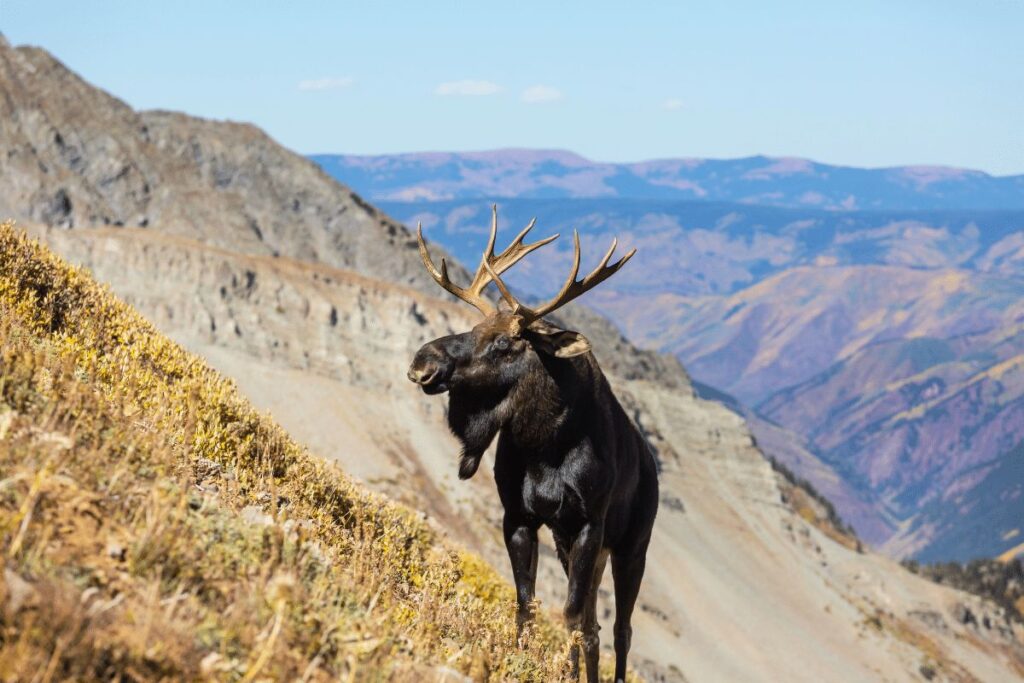
Their coat is usually a mix of dark brown to almost black, with long legs that seem specially designed to navigate the deep snow and wetlands with ease.
In Ashley National Forest, the areas around Flaming Gorge and the High Uintas Wilderness offer the best chances of spotting these giants.
For the intrepid hiker, like us, trails such as the East Park Reservoir or the Uinta River Trail might provide the rare joy of a moose sighting, especially during the early mornings or late afternoons.
Moose thrive in habitats that are abundant in freshwater sources. Marshes, ponds, and lakeside regions in the forest are their preferred domains.
They are often seen munching on aquatic plants, which form a substantial part of their diet.
An interesting tidbit: moose are exceptional swimmers! They can dive deep to forage underwater plants and can swim several miles without a break.
This skill is particularly helpful in evading predators and navigating the varied landscapes of Ashley.
Though they might appear gentle and unhurried, it’s crucial for visitors to give moose their space. Especially during the mating season in fall or when cows are with their calves, they can become particularly protective and aggressive.
Mountain lion
Mountain lions, also known as cougars or pumas, are one of the more elusive residents of Ashley National Forest.
Their sleek, muscular bodies are covered in a tawny coat, enabling them to seamlessly blend into their surroundings.
With a long tail often tipped in black and sharp, retractable claws, they are the epitome of feline grace and power.
When it comes to size, mountain lions are second only to jaguars among big cats in the Americas. Despite their size, they move with an almost ghostly silence, making them exceptional hunters.
Their favored prey includes deer, but they’re known to be opportunists, preying on smaller mammals when necessary.
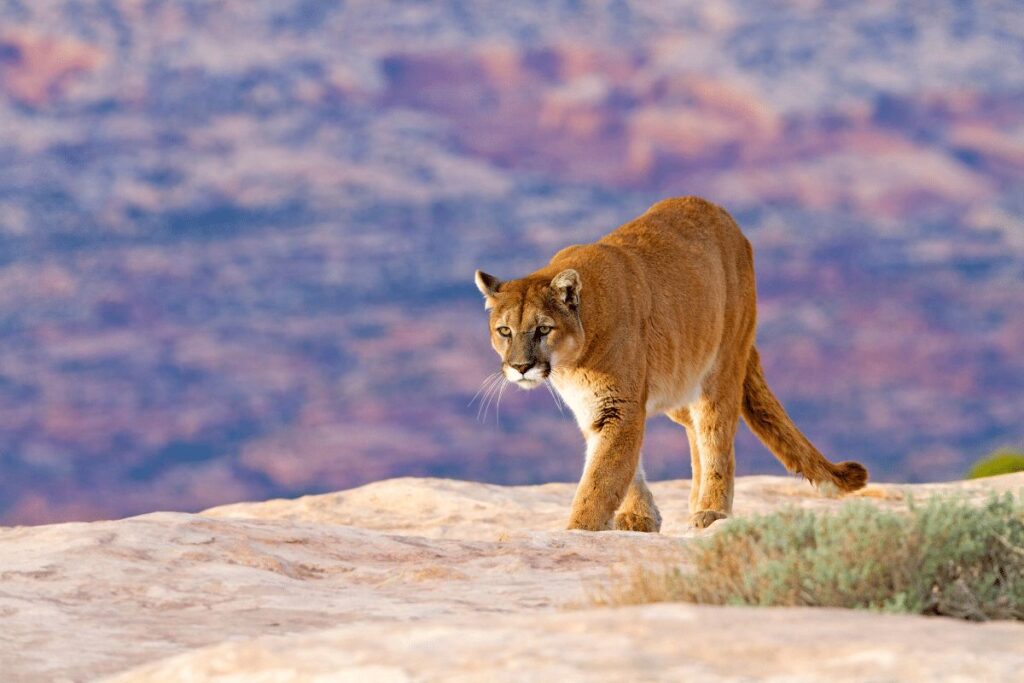
Ashley National Forest provides an ideal backdrop for these elusive predators. The dense forests and rugged terrains of areas like the Duchesne River and Leidy Peak are often their chosen habitats.
If you’re hiking trails such as the Whiterocks Canyon or the Swift Creek Trail, you might be in the realm of the mountain lion. However, sightings are rare, given their secretive nature and predominantly nocturnal habits.
One of the most intriguing aspects of the mountain lion is its adaptability. They inhabit a variety of ecosystems, from mountainous terrains to lowland areas, always close to cover for stalking prey.
A lesser-known fact about these felines is their communication method. They can’t roar like lions of Africa; instead, they communicate through hisses, growls, purrs, and even chirps, especially between a mother and her cubs.
The presence of mountain lions in Ashley National Forest is a testament to the pristine conditions and rich biodiversity of the area. They stand as symbols of the wild, uncharted terrains that beckon every nature lover to explore deeper into the forest’s embrace.
Black Bears
The black bear, a symbol of North America’s dense woodlands, is also a resident of the sprawling landscapes of Ashley National Forest.
With its compact ears, expressive eyes, and shaggy black coat—though occasionally you might spot one in a cinnamon hue—it stands as a delightful spectacle for the wildlife enthusiast.
Black bears are considerably smaller than their grizzly counterparts but make up for their size with their sheer adaptability. From dense forests to open meadows, these creatures have made various habitats their own, always within reach of their favorite foods.
Within the expanse of Ashley National Forest, black bears are often drawn to areas rich in berries and nuts, especially during late summer and early fall.
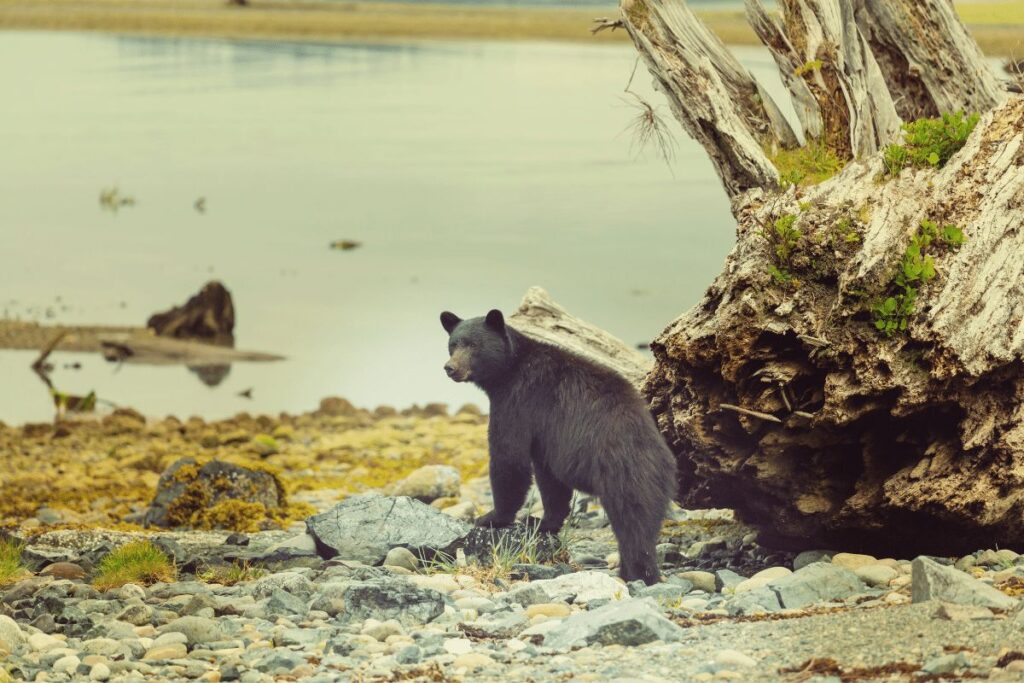
The Red Cloud Loop or the Bear River area are spots where they’ve been occasionally sighted, often leaving behind clues of their presence like upturned rocks or clawed tree trunks.
Their omnivorous diet includes plants, nuts, berries, insects, and occasionally small mammals. However, one of the bear’s most cherished treats is honey.
Their keen sense of smell, which is seven times stronger than that of a dog, leads them to beehives, where they skillfully extract honey, undeterred by bee stings.
The adaptability of black bears extends to their climbing abilities. Young bears, especially, are known to scamper up trees with an ease that belies their size. This skill serves them well, both for feeding on high tree branches and escaping threats.
Despite their often solitary and peaceful nature, it’s essential to remember the wild essence of black bears.
While they might seem curious and nonchalant, it’s crucial for visitors to keep a respectful distance, ensuring neither the bear nor the human is startled.
An endearing aspect of black bear behavior is their winter hibernation. In preparation, they consume vast amounts of food, storing it as fat, which then sustains them through the colder months when they retreat to their dens.
As you meander through the trails of Ashley National Forest, the possibility of a black bear sighting adds a thrill to the experience.
They stand as gentle reminders of the raw, untamed beauty of nature, urging us to tread lightly and respect their world.
Elk
The elk, with its regal demeanor and statuesque presence, graces the landscapes of Ashley National Forest, creating moments of awe for every nature enthusiast.
Often seen in large herds, these animals, also known as wapiti, are among the largest species within the deer family.
Distinctive for their impressive antlers, which are shed and regrown annually, male elk, or bulls, are a magnificent sight, especially during the rutting season.
Their bugles, ranging from deep tones to high-pitched screams, resonate through the forest, signaling both a call for mating and a declaration of territory.
Elk are primarily grazers, feeding on grasses, plants, and leaves. But in Ashley National Forest, they’ve also been known to browse on tree bark, especially during the harsher winter months.
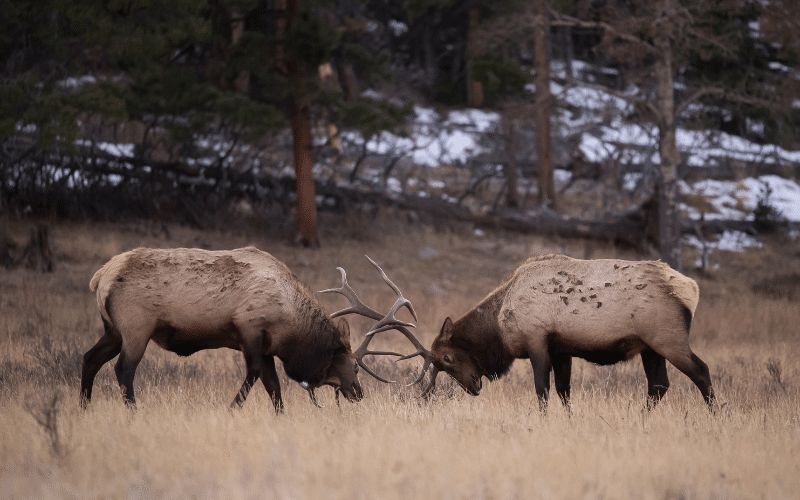
The vast meadows and open spaces, like those around the Leidy Highlands or near the Spirit Lake, are some of the places where you might witness these magnificent creatures grazing or resting.
An interesting aspect of elk behavior is their migratory pattern. They often travel to higher elevations in the summer to escape the heat, returning to lower terrains in the winter to access food sources.
This seasonal movement, known as the “elk rut,” offers a dynamic view of their communal behavior.
For those treading the trails like the Moon Lake pathway or the Cedar Loop, an elk sighting can be both enchanting and educational.
Watching them interact, with calves playfully chasing each other or bulls locking antlers in friendly skirmishes, provides a glimpse into their intricate social structures.
Though generally peaceful, it’s crucial to remember that elk are wild creatures. Bulls, especially during the rutting season, can become aggressive, so maintaining a safe distance and using binoculars or a telephoto lens for a closer look is recommended.
Mule deer
The mule deer, with its large, iconic ears reminiscent of a mule’s, is an emblematic sight within Ashley National Forest.
These graceful creatures, agile and alert, add an endearing charm to the forest’s diverse tapestry of wildlife.
Distinguished from the white-tailed deer by its broader antlers that fork as they grow, the mule deer is a marvel to observe.
The antlers, predominantly sported by the bucks, serve as a testament to their age and vitality, reaching their peak size in the deer’s prime years.
Within the varied terrains of Ashley National Forest, mule deer often prefer the edges where forests meet open spaces.
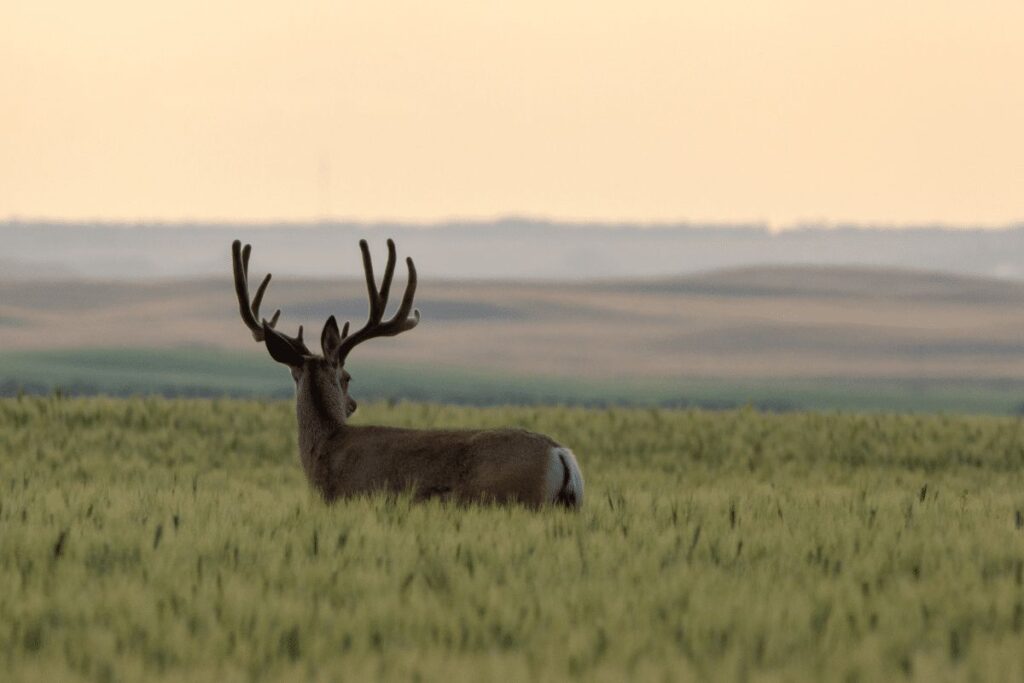
They’re creatures of the dawn and dusk, making the transitional hours the best time to catch a glimpse of them. Areas around the Carter Creek and the North Slope Road are spots where these deer frequently graze, moving with a peculiar bounding leap when startled.
Primarily browsers, their diet includes a medley of shrubs, plants, and leaves. As the seasons shift, so do their preferences, with a winter diet richer in twigs and evergreen leaves and a summer palate favoring the fresh green growth.
One of the intriguing aspects of mule deer behavior is their keen sense of adaptability. While they’re often seen at lower elevations during the harsh winter months, seeking shelter and food, they ascend to higher grounds in the summer, capitalizing on the rich vegetation.
For those exploring trails such as the Marsh Peak or the Bear Lake Loop, the subtle rustling of leaves or a soft footfall might indicate the presence of mule deer nearby. They often move in groups, with the does leading their fawns on foraging expeditions.
Though they exude a sense of calm and gentleness, caution is essential. Like all wild animals, mule deer deserve respect and space, especially during the birthing season when does can become particularly protective of their young.
In the vast expanses of Ashley National Forest, the mule deer stands as a symbol of the wilderness’s quiet elegance, a reminder of the delicate balance of nature and the joys of wild encounters.
Pronghorn Antelope
The pronghorn antelope, often simply called pronghorn, adds a distinctive touch to the vast landscapes of Ashley National Forest. While not true antelopes, they’ve earned the moniker due to certain similarities in appearance and behavior.
Their sleek, tan bodies contrasted with white patches and uniquely structured horns make them an unmistakable sight.
The horns of the pronghorn, from which they derive their name, are fascinating. Both males and females have them, but it’s the males that boast the more pronounced, pronged versions.
Unlike deer antlers, pronghorns shed the outer sheath of their horns annually, revealing a bony core beneath.
Within the vast terrains of Ashley National Forest, pronghorns favor the more open spaces, where their incredible vision – believed to be among the keenest in the animal kingdom – allows them to spot predators from great distances.
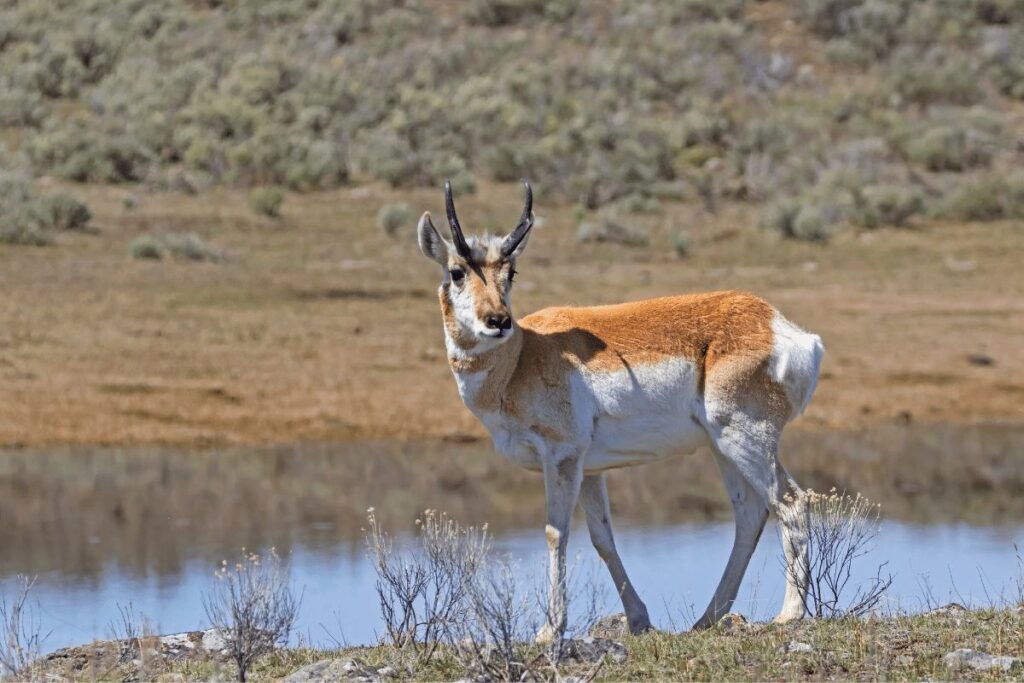
The grassy plateaus near the Burnt Fork or expansive clearings around the Brush Creek area offer ample opportunities to witness these swift creatures in their natural habitat.
Renowned for their unmatched speed, pronghorns are North America’s fastest land animals.
Capable of reaching speeds up to 55 mph, they’ve evolved to escape predators with bursts of incredible velocity, often maintaining high speeds for considerable distances.
This has earned them a somewhat poetic nickname, “the ghosts of the plains.”
Their diet primarily comprises grasses, shrubs, and forbs. As the seasons transition in Ashley National Forest, pronghorns adapt by seeking out the most nutritious vegetation available, ensuring they’re fueled for their energetic lives.
For travelers venturing along paths such as the Bluebell Knoll or the Kings Meadow trails, the sight of a pronghorn herd dashing across the horizon can be both exhilarating and humbling.
Their graceful movements, synchronized and purposeful, are a dance of nature that speaks of both fragility and strength.
While generally not aggressive, pronghorns are wild animals and can be quite skittish. A safe distance and a quiet approach, coupled with the use of optics, can ensure a memorable encounter without causing distress to the animals.
The presence of pronghorns in Ashley National Forest is a testament to the region’s rich biodiversity.
Their graceful silhouettes against the backdrop of vast landscapes serve as a beautiful reminder of the wild spirit that thrives within the forest’s boundaries.
Bighorn sheep
Bighorn Sheep, with their magnificent spiraled horns, are undeniably among the most iconic residents of Ashley National Forest. These sure-footed animals are a testament to nature’s ability to adapt and thrive in rugged terrains.
Males, known as rams, are easily distinguishable by their heavy, curled horns, which can be a symbol of status and age. These horns are not just for show; they are used in dramatic head-butting clashes to establish dominance.
Venture into the steep, rocky outcrops near areas like the High Uintas Wilderness, and you might be fortunate enough to spot these creatures. Their ability to scale near-vertical cliffs and navigate rocky ledges is nothing short of awe-inspiring.
It’s in these high terrains that the bighorns find their favored meals, grazing on a diet of grasses during summer and browsing shrubs in the winter when snow blankets the ground.
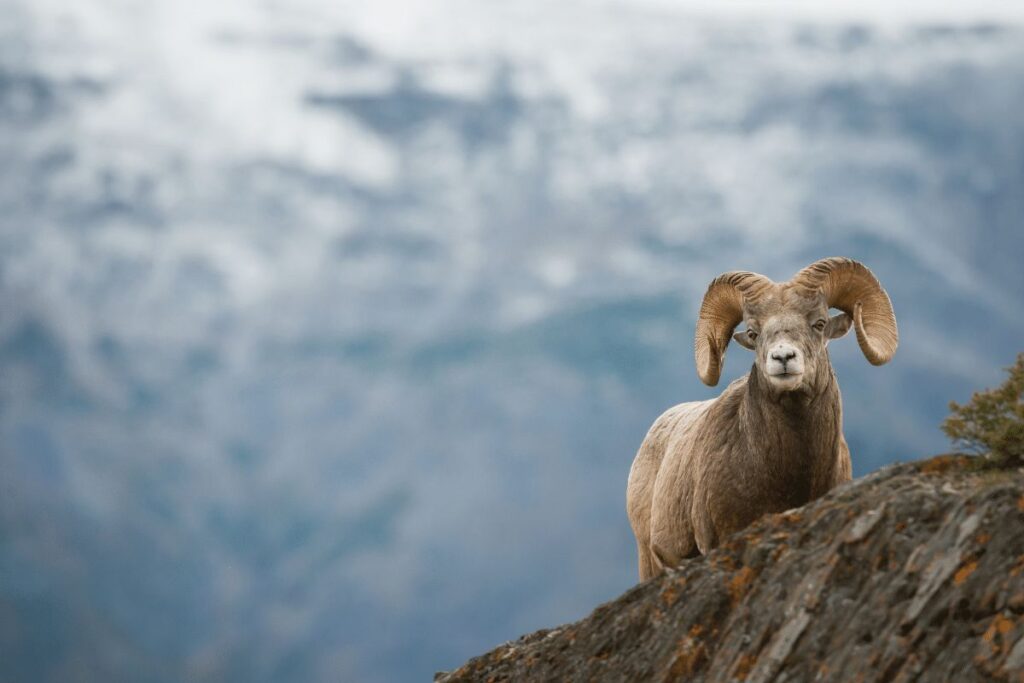
Interestingly, their split hooves and rough hoof bottoms provide the grip they need to climb the steep, rugged cliffs, keeping them safe from many ground predators.
While this ability to escape to high grounds offers safety, it also provides them with vantage points to scan their surroundings, always alert to the movements below.
For the hiker or nature enthusiast wandering the trails around Leidy Peak or the East Park Reservoir, the sudden sight of a bighorn herd, with the sun glinting off their majestic horns, can be the highlight of their journey.
The younger lambs, nimble and curious, offer delightful moments of playfulness as they learn the ropes of their challenging habitat.
Yet, for all their grandeur, bighorns are quite approachable, often appearing unperturbed by human presence. But like all wild animals, they command respect and a cautious approach.
Observing them from a distance ensures their peace is undisturbed, and their natural behaviors remain unaltered.
The bighorn sheep stand as proud sentinels of the high cliffs and rocky terrains. Their presence speaks of an ancient bond with the land, a dance of survival and grace that continues through the seasons.
Every sighting, every moment spent watching them, is a gentle reminder of the raw, untamed beauty of the natural world.
Weasels
In the shadowed nooks and hidden corners of Ashley National Forest, the weasel goes about its business with an agile grace that belies its predatory nature.
These slender-bodied mammals, with their sharp features and keen eyes, are a lesson in adaptability and tenacity.
With a coat that’s a rich brown during the warmer months, weasels have a unique ability to shift their appearance with the seasons.
Come winter, they don a snowy white fur, offering them a perfect camouflage against the white landscapes of Ashley’s colder regions.
This change isn’t just about aesthetics; it’s a crucial survival tool, allowing them to stealthily approach their prey.
These creatures are primarily carnivorous, with a preference for small rodents. Their diet makes them invaluable within the ecosystem, ensuring populations of mice, voles, and other small animals are kept in check. Their hunting style is a combination of stealth and speed, often surprising their prey with rapid, darting movements.
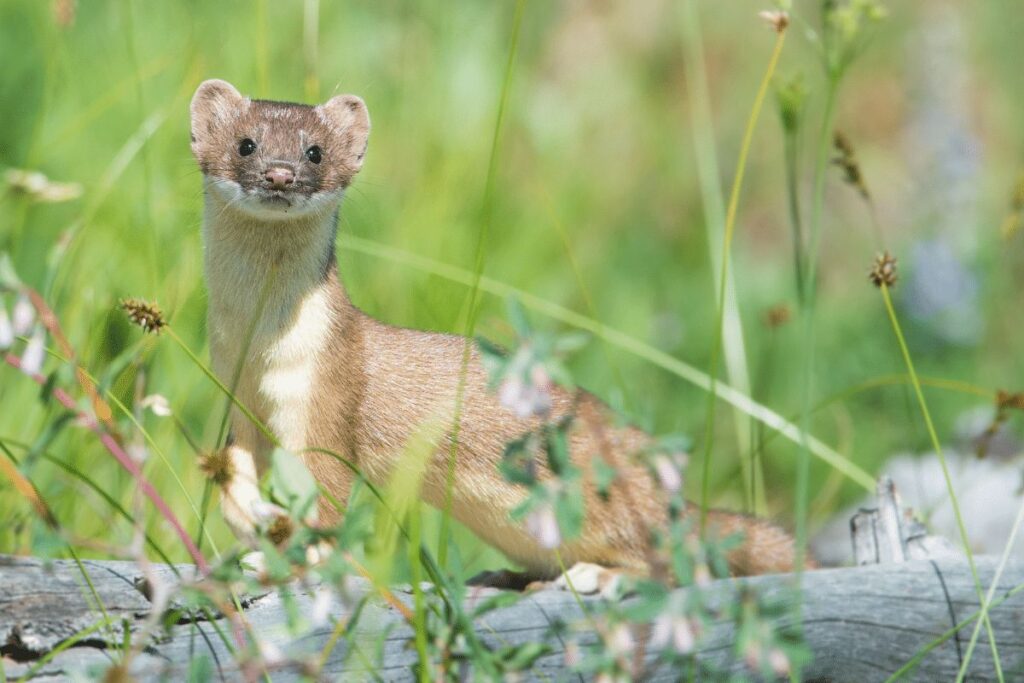
The dense underbrush and forested areas near regions like the Green River offer prime habitats for weasels. Here, they create burrows and nests, often repurposing the abandoned homes of their prey.
A rustle in the leaves, a quick movement from the corner of one’s eye, might be the only indication of a weasel’s presence.
While their size might suggest vulnerability, weasels are known for their boldness. They won’t shy away from prey larger than themselves and have been known to take on animals several times their size with a fierce determination.
This courage, combined with their agility, makes them formidable hunters in their own right.
For those wandering the trails of Ashley, such as the Swift Creek Path or the Moon Lake surroundings, spotting a weasel can be both a challenge and a reward. Their elusive nature means that patience and a keen eye are required.
However, those lucky enough to observe their antics, whether hunting or playfully chasing their own tails, are in for a memorable experience.
Badgers
Amidst the varied landscapes of Ashley National Forest, the badger, with its stocky body and distinctive face markings, carves out its own niche.
With a grizzled appearance that suggests both ruggedness and tenacity, these burrowing mammals are true masters of the underground realm.
Badgers sport a broad, flat body with short, robust legs. Their greyish coat, combined with the striking black and white facial stripes, renders them unmistakable.
Those powerful front claws aren’t just for show; they’re essential tools, designed for digging through even the toughest terrains.
It’s beneath the ground that badgers create their intricate network of tunnels and chambers, known as setts.
These underground homes provide shelter, a place to rear their young, and a safe haven from potential predators. If you find large mounds of dirt while exploring regions near Carter Creek or the Bear River area, it might just be a sign of a badger’s diligent digging nearby.
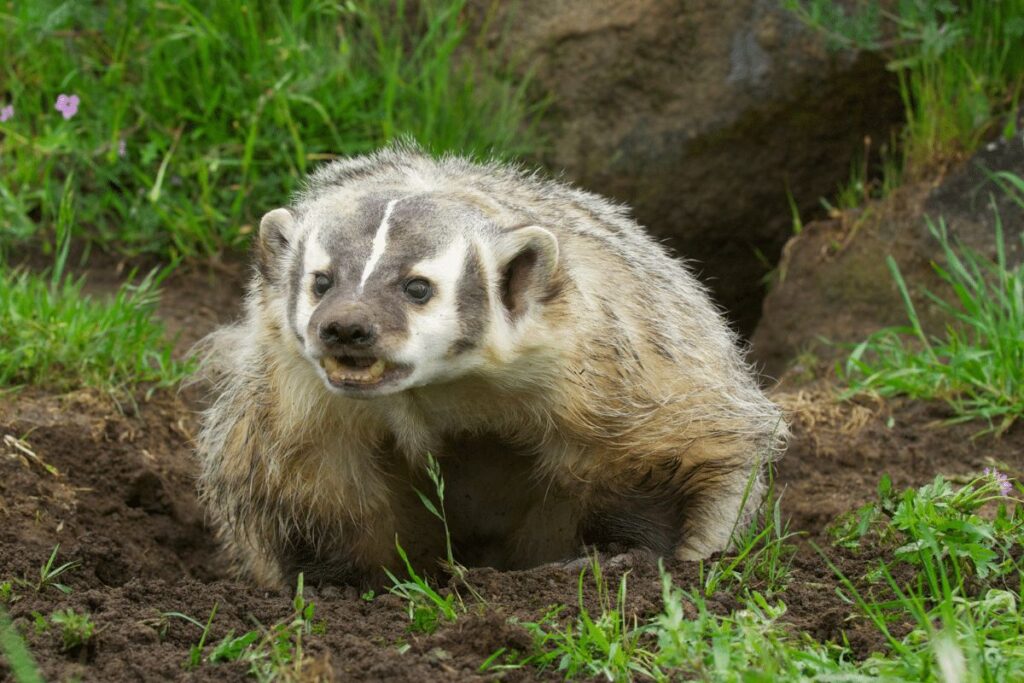
Primarily nocturnal, badgers emerge at dusk to forage. Their diet is diverse, ranging from small rodents to insects and earthworms.
Their keen sense of smell aids them in locating prey beneath the surface, and with a swift dig, they can access their subterranean targets.
Their somewhat solitary nature means that while they share territories with other badgers, they often prefer to forage alone. However, during the breeding season, you might spot pairs or even mothers guiding their young through the forest’s underbrush.
Spotting a badger in Ashley National Forest requires a blend of patience and luck. Dawn or twilight hikes, especially around the more open regions of Marsh Creek or Brush Creek Basin, might reward the observant traveler with a glimpse of these creatures.
Though they might appear somewhat docile, badgers are known for their ferocity when cornered or threatened. As such, maintaining a respectful distance is crucial to ensure both the safety of the observer and the badger.
Mountain Goats
High atop the rugged peaks and craggy cliffs of Ashley National Forest, the mountain goat stands as a sentinel, its white coat contrasting vividly against the rocky backdrop.
These nimble climbers, with their sharp hooves and robust bodies, are built to navigate the treacherous terrains they call home. A closer look reveals their piercing eyes, which are always alert, scanning the horizon for both food and potential threats.
Though not native to Utah, mountain goats have found a favorable habitat within the forest, especially around the lofty areas of King’s Peak and Gilbert Peak.
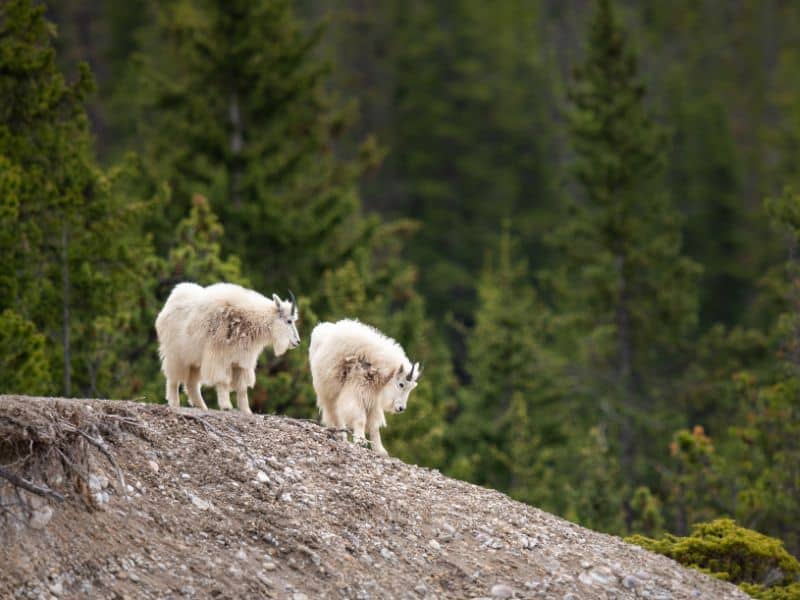
Their diet primarily consists of grasses, herbs, lichens, and mosses, which they forage with determination, even amidst snow-covered landscapes.
One of the most captivating sights is that of a mother goat, or nanny, leading her young kid across a seemingly impossible ledge, teaching the ropes of mountain life.
These lessons are crucial, for the heights they scale often offer protection from many ground predators.
For the avid hiker or climber venturing into the higher altitudes of Ashley National Forest, the reward might be a serene encounter with these majestic creatures, their ethereal beauty amplified by the pristine alpine environment they inhabit.
Bobcats
Stealth, grace, and a hint of mystery define the bobcat, one of Ashley National Forest’s more elusive residents. With tufted ears, a ruffed face, and a short, “bobbed” tail, bobcats possess a wild beauty that captivates the observer.
Their coat, a mottled blend of gray, brown, and reddish hues, offers them the camouflage they need to move unseen through the forest underbrush.
Densely wooded areas, especially those near Red Canyon or Dry Fork, are prime bobcat territories. These adaptable felines can thrive in various habitats, from forests and mountainous regions to semi-deserts.
Small mammals like rabbits, birds, and rodents form the bulk of their diet, although they aren’t averse to tackling larger prey when the opportunity presents itself.
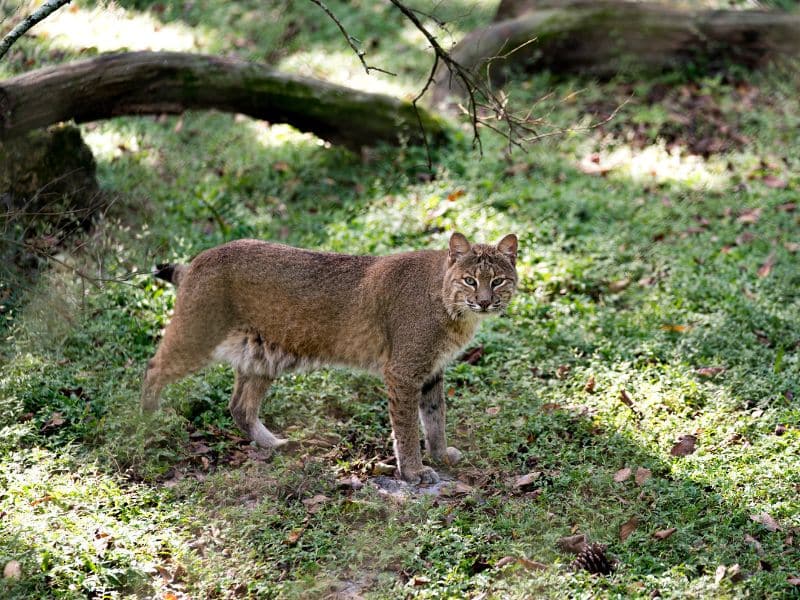
The art of spotting a bobcat in the wild is a game of patience. Dawn and dusk, their peak activity hours, might offer the lucky traveler a brief glimpse of this feline on the prowl.
Their keen senses, especially their acute hearing, aid them in locating and stalking their prey with an almost ghostly silence.
River Otters
The playful antics of river otters are truly a delight to behold. These agile, streamlined mammals, with their glossy fur and expressive eyes, are perfectly adapted to their aquatic habitats.
Whether they’re sliding down muddy riverbanks, chasing after fish, or simply floating on their backs, otters bring a touch of joy and whimsy to the waterways of Ashley National Forest.
Major water bodies within the forest, like the Flaming Gorge Reservoir or the streams branching from the Uinta Mountains, often harbor these aquatic acrobats.
Their diet, rich in fish, crayfish, and various aquatic insects, keeps them constantly on the move, searching for their next meal with keen eyes and a sensitive whiskered snout.
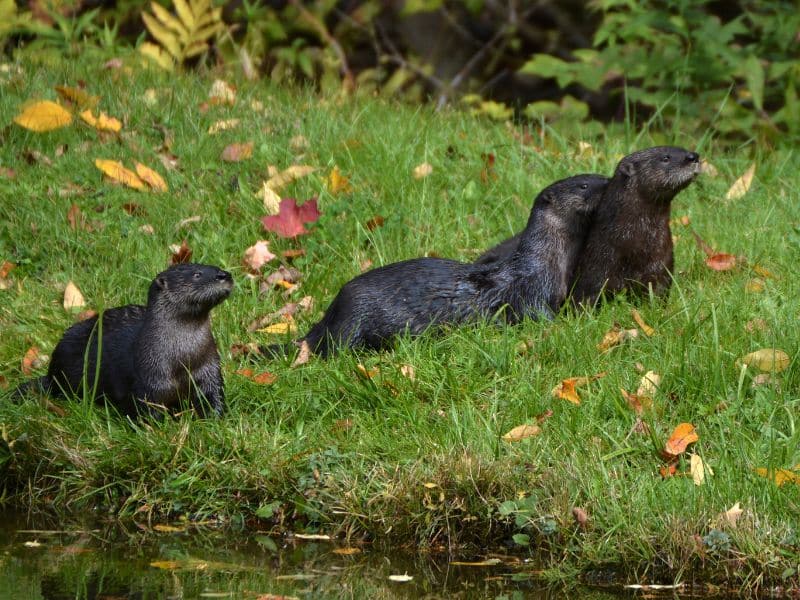
Family is central to the otter’s world. Observing a mother with her pups, teaching them the ways of the water, is a heartwarming spectacle.
Their social nature, combined with their insatiable curiosity, often leads to synchronized swimming displays and group hunting sessions.
For those exploring the wetlands and riverbanks of Ashley National Forest, the sudden splash or the ripple in the water might just be a sign of an otter’s presence, a fleeting moment of connection with these joyful creatures.
Raccoons
The masked face of the raccoon, paired with its dexterous hands, has earned it a reputation for mischief and curiosity.
These nocturnal omnivores, with their grayish coat and distinctive black “mask,” are skilled foragers and adapt well to a variety of environments.
Ashley National Forest, especially regions near water sources like Duchesne River or Swift Creek, is home to these resourceful creatures.
Fallen logs, dense underbrush, and tree hollows often serve as their resting spots during the day. Come night, their world comes alive.
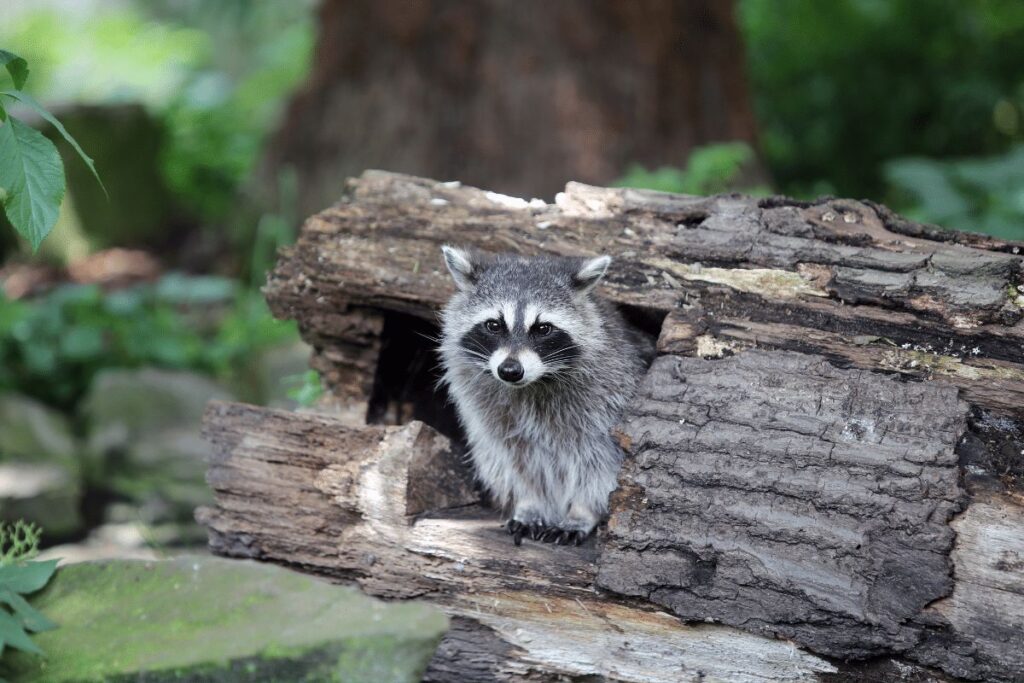
Raccoons venture out, using their sensitive fingers to explore, manipulate, and source food, which ranges from fruits and plants to small animals and insects.
One can’t discuss raccoons without mentioning their impressive adaptability. They are just as comfortable rummaging through a campsite as they are fishing for crayfish along a stream.
This adaptability, however, requires campers and visitors to be vigilant about securing their food and waste, ensuring both human and animal safety.
For the traveler walking the trails of Ashley National Forest under the cover of night, the soft rustling of leaves or the shimmer of eyes reflecting torchlight might indicate a raccoon’s curious approach, a quiet reminder of the forest’s nocturnal wonders.
Absolutely! Here’s a dedicated section on the avian wonders that grace Ashley National Forest:
Birdwatching in Ashley National Forest
Ashley National Forest serves as a veritable paradise for bird enthusiasts.
With its diverse range of habitats, from lush meadows and dense coniferous woodlands to serene lakes and rippling streams, the forest shelters a myriad of bird species that provide endless opportunities for observation and wonder.
Begin your avian journey in the dense thickets, where you might spot the vibrant Western Tanager flitting about, or hear the melodious song of the Hermit Thrush.

The higher altitudes are the domain of the Mountain Bluebird, with its ethereal blue hue, and the Clark’s Nutcracker, known for its remarkable memory and seed-storing habits.
The water bodies within the forest, like the Moon Lake or the Green River, attract a different set of feathered marvels. Here, ospreys soar in search of fish, while the American Dipper dives and bobs, foraging in the crystal-clear waters. The haunting calls of the Common Loon might serenade you during a misty morning by the lakeside.
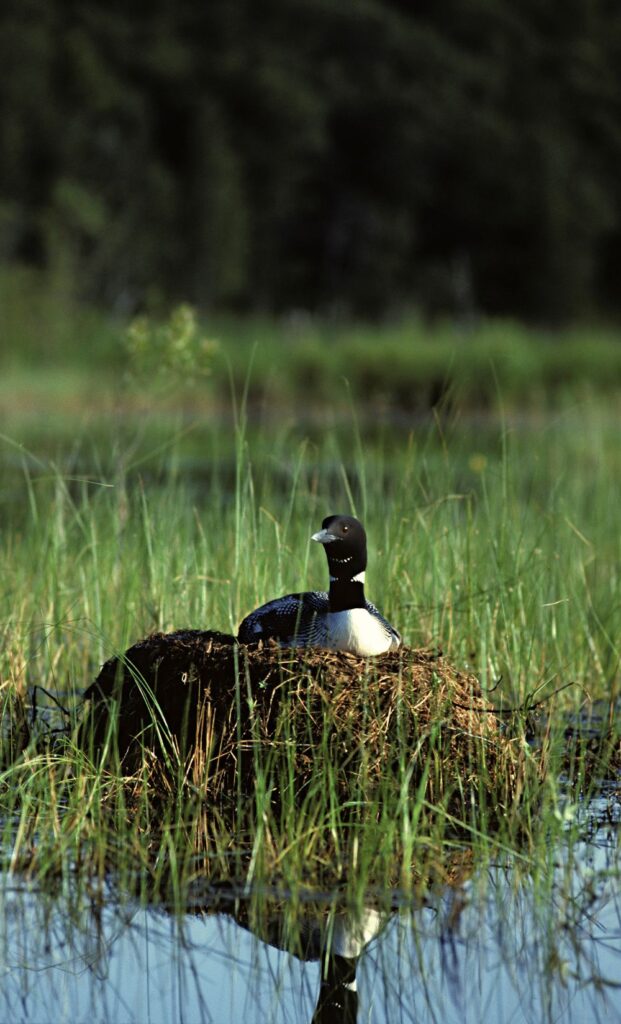
For those interested in raptors, the forest does not disappoint. Majestic bald eagles can often be seen perched high above, scanning the terrain for prey, while Red-tailed Hawks ride the thermals, their piercing cries echoing through the valleys.
Of course, no birdwatching experience in Ashley would be complete without the smaller wonders. Warblers, finches, and sparrows dart amidst the underbrush, each with their own distinct calls, patterns, and behaviors to decipher.
Armed with a pair of binoculars and a reliable field guide, the patient observer can unravel the many avian mysteries that Ashley National Forest holds. The key is to move slowly, listen intently, and allow the forest to reveal its winged secrets.
With every visit, the symphony of calls, songs, and flights adds a new chapter to one’s personal connection with this remarkable wilderness.
Best Times and Locations to Spot Wildlife in Ashley National Forest
For the nature aficionado, Ashley National Forest presents an array of wildlife-watching opportunities.
However, maximizing your chances of encounters requires a blend of timing, location, and a touch of patience. Here are some insights to guide you on your next adventure.
1. Early Morning & Dusk: Wildlife is most active during the cooler hours of early morning and late evening.
Not only is this when many animals are out foraging, but the soft light of dawn and dusk also offers a captivating backdrop for photographs.
2. Seasons Matter: Different times of the year bring varied wildlife activity.
Spring is a season of renewal, with animals emerging from hibernation and birds returning from their southern migrations.
Summer sees young animals taking their first steps, while autumn offers the spectacle of migrations and preparation for the coming cold.
Winter, though challenging, presents its own stark beauty and opportunities, especially for tracking animals in the snow.
3. Water Sources: Areas around lakes, rivers, and wetlands, such as the edges of Flaming Gorge Reservoir or the banks of the Duchesne River, are always promising.
They serve as life sources for many species and act as hubs of activity, especially during drier months.
4. Meadows and Open Areas: Open spaces like Leidy Peak meadows or the expansive grasslands around Dry Fork are excellent for spotting ungulates like elk, mule deer, and pronghorn antelope.
The visibility offered by these spaces means you can often observe from a distance without disturbing the creatures.
5. Trails Less Traveled: Popular trails might offer convenience, but for a more intimate wildlife experience, venture onto lesser-known paths.
Areas like the remote expanses of the High Uintas Wilderness can provide more authentic and undisturbed encounters.
6. Elevation Points: Higher elevations, such as those around Gilbert Peak or King’s Peak, offer unique wildlife like mountain goats and pikas.
The challenging terrain is often less frequented, making it a haven for certain species.
7. Campsites and Picnic Areas: While it’s essential to ensure food is securely stored to avoid attracting wildlife to campsites, areas around established sites can sometimes offer glimpses of creatures like raccoons or birds, curious about the human visitors.
In all your excursions, always prioritize safety—for both you and the wildlife. Keep a respectful distance, avoid feeding or approaching animals, and always adhere to the park’s guidelines.
Photographing Wildlife in Ashley National Forest
Capturing the natural splendors of Ashley National Forest requires a blend of patience, knowledge, and respect for the wilderness.
Photographing wildlife, in particular, can be both challenging and immensely rewarding.
Here are some guidelines to help you frame those perfect moments without disturbing the natural harmony.
1. Equip Yourself Right: A DSLR or mirrorless camera with a telephoto lens is ideal for wildlife photography.
The long focal length allows you to shoot from a distance, ensuring that animals remain undisturbed.
A tripod can also be beneficial for stability, especially in low light conditions.
2. Understand Your Subject: Do some research before venturing out.
Understanding the behavior, habits, and habitats of the animals you wish to photograph can significantly increase your chances of capturing meaningful shots.
3. Patience is Key: Wildlife won’t always appear on cue.
Sometimes, you might have to wait hours for that perfect moment.
Embrace the waiting; it’s a chance to immerse yourself in the surroundings and truly connect with nature.
4. Use Natural Light: The soft light of early morning or late afternoon is often ideal.
Not only does it give a warm, golden hue, but animals are typically more active during these times.
5. Be Stealthy and Respectful: Move slowly and avoid making loud noises. Always maintain a safe and respectful distance.
If an animal appears stressed or disturbed by your presence, it’s time to back away.
6. Frame with the Environment: While close-ups are impactful, sometimes capturing the animal in its natural setting provides a more profound narrative.
It tells a story about the creature’s habitat and its place in the ecosystem.
7. Know Your Camera: Familiarize yourself with your equipment.
Being able to adjust settings quickly, like shutter speed or ISO, can make the difference between a missed opportunity and a magical shot.
8. Stay Safe: Remember, while animals can look serene, they’re wild creatures with unpredictable behavior.
Always prioritize your safety and that of the animals. Carry bear spray if recommended, and be aware of your surroundings.
9. Ethical Photography: Never bait or lure animals for a shot. It’s dangerous and can alter their natural behaviors.
Your photos should reflect the genuine essence of the forest and its inhabitants.
10. Post-Processing: While capturing the shot is vital, sometimes a bit of post-processing can enhance the image.
Adjusting the brightness, contrast, or cropping can help the subject stand out more.
Key Takeaways
Diverse Wildlife: Ashley National Forest is home to a rich tapestry of animals, from majestic moose and elusive mountain lions to the nimble-footed bighorn sheep and the nocturnal raccoons.
Birdwatcher’s Haven: With varied habitats, Ashley attracts a plethora of bird species, making it a top spot for bird enthusiasts.
Timing is Everything: Early mornings and dusk are the optimal times to spot wildlife, given the animals’ increased activity during these cooler hours.
Strategic Locations: Certain areas like meadows, water sources, and higher elevations provide better chances of wildlife encounters.
Safety First: While the forest offers intimate experiences with wildlife, always prioritize personal safety and the well-being of the animals.
Capture the Moment: Photographing wildlife requires a mix of patience, equipment knowledge, and ethical practices. Respect for the animal and its habitat should always be at the forefront.
Engage and Learn: Each animal has its unique behavior, appearance, and role in the ecosystem. The forest is a living classroom where observation can lead to profound insights about nature.
Protect and Preserve: While enjoying the beauty of Ashley National Forest, remember the importance of conservation. Each visitor plays a role in ensuring that future generations can enjoy the same splendors.
Exploring Ashley National Forest offers a blend of adventure, relaxation, and education. By keeping these takeaways in mind, visitors can maximize their experience while acting as stewards for this beautiful slice of wilderness.
Conclusion
Camping in Ashley National Park can be a great way to experience nature and see some incredible animals. We hope this article has given you an idea of what kind of animals you can expect to encounter while camping in the park.
From deer and elk, to raccoons and hawks, there is something for everyone who loves wildlife! So pack your tent and head out on your next outdoor adventure; you never know what kind of furry friends you’ll meet along the way!
Overall, camping in Ashley National Park is an experience of a lifetime and one that you won’t forget. While it can be challenging, it’s also incredibly rewarding. With proper planning and preparation, you can make sure that your trip is as safe and enjoyable as possible. Remember to leave no trace and keep the park clean, so future generations can enjoy all that Ashley National Park has to offer!

